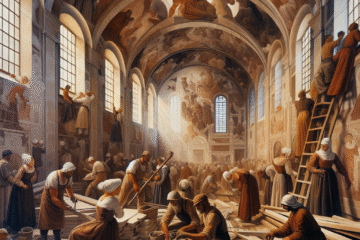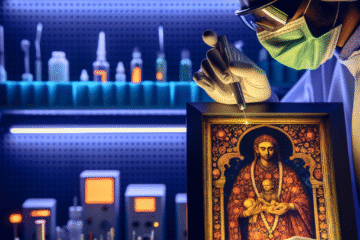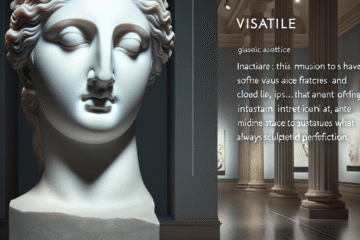Introduction: Architecture of the Divine and Earthly Power
When one tilts their head to gaze upon the Sistine Chapel ceiling, they are not merely admiring a masterpiece of religious art—they are entering a potent visual dialogue between theology, humanism, and political authority. During the Renaissance, frescos painted on ceilings became more than decorative artistry; they were immersive cosmologies that symbolized the convergence of divine order and earthly rule. Michelangelo’s famed frescoes do more than illustrate Biblical stories—they assert theological truths, reflect the philosophical ideals of humanism, and subtly reinforce Papal sovereignty.
Chapter 1: Medieval Foundations—The Ceiling as Heaven’s Mirror
Before the Renaissance, ceiling art was largely symbolic, rooted in medieval Christian iconography. Churches and basilicas from the Byzantine to Gothic periods adorned their vaults with stars, saints, and mandorlas, creating a metaphoric firmament that reinforced the celestial role of God. These spaces were designed to humble the spectator, drawing their eyes (and souls) upward, away from the material world. Medieval ceilings reinforced the separation between the temporal and the eternal. Art served the Church’s authority with divine clarity, but lacked the personal dimension that the Renaissance would soon embrace.
Chapter 2: The Renaissance Ceiling—Birthplace of Synthesis
The Renaissance era unleashed a revitalized interest in classical antiquity, human anatomy, and individual experience. With this shift, ceilings evolved from heavenly mirrors to dynamic canvases for philosophical inquiry and humanistic theology. Perspective techniques refined by artists like Masaccio and Brunelleschi enabled more illusionistic spaces, transforming ceilings into gateways between heaven and earth. Michelangelo’s Sistine Chapel ceiling, commissioned by Pope Julius II, is not just a visual representation of Genesis—it is a Renaissance manifesto. The image of the near-touch between God and Adam encapsulates the potential for divine-human synergy, a dangerous yet exhilarating idea in an age of Church reform and political contention.
Chapter 3: Papal Propaganda—Power in Pigment
While Michelangelo’s genius is celebrated, the political motives behind the Sistine Chapel’s themes are crucial to understanding their true intent. Pope Julius II sought not only spiritual renewal but political legitimacy at a time when the Papacy’s temporal power was frequently contested. By commissioning monumental works that fused divine authority and classical grandeur, Julius II effectively fused the roles of high priest and Roman emperor. The Sistine ceiling, with its muscular prophets and sibyls borrowed from Greco-Roman tradition, symbolized a universal church grounded in knowing pasts and present dominion—a Renaissance theocracy painted in frescoed stone.
Chapter 4: Ceiling as Stage—Baroque and the Theater of Power
The late Renaissance and Baroque periods extended the ceiling metaphor into theatrical realms. Artists like Pietro da Cortona and Giovanni Battista Gaulli turned ceilings into immersive spectacles using trompe-l’œil techniques and dynamic movement. The illusion of heaven opening above the viewer drew them not only into spiritual awe but into a visual narrative that underscored the triumph of the Church amid political turmoil—especially during and after the Counter-Reformation. These ceilings did not merely depict power; they performed it, engaging the audience in a spectacle that dramatized salvation and submission simultaneously.
Chapter 5: Legacy and Modern Echoes
Even beyond the Renaissance and Baroque periods, the metaphor of the ceiling as a domain of power and divinity endures. In 19th-century state buildings, as in banks and courthouses, ceilings echoed neoclassical grandeur to assert the authority of law and reason. In the 20th century, artists like Diego Rivera adapted fresco traditions to wall murals with revolutionary themes—bringing the grandeur of ceiling metaphor down to the level of the people. Today, contemporary installations that explore spatial experience often refer, whether directly or indirectly, to this legacy: the ceiling remains a canvas for aspirations—divine, political, or personal.
Conclusion: Looking Up, Seeing Power
The Renaissance ceiling fresco exemplifies the merging of art, philosophy, and politics in visual form. Whether in Michelangelo’s creation scenes or Cortona’s exploding heavens, these ceilings function as symbols of ideological alignment—between visionary theology, humanist ideals, and calculated displays of supremacy. They ask the viewer not only to look upward but to think upward—into the realms of power, eternity, and meaning. To view these frescoes is to engage in a dialogue between the visible and the invisible, a conversation started more than 500 years ago that still resonates above us.

Image description:
Looking up at the sistine chapel ceiling from the transenna
License:
CC BY-SA 4.0
Source:
Wikimedia Commons


